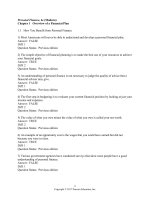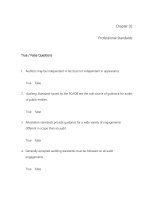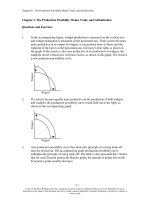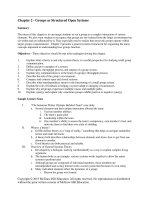Solution manual and test bank preparing your FIrst presentation (2)
Bạn đang xem bản rút gọn của tài liệu. Xem và tải ngay bản đầy đủ của tài liệu tại đây (488.8 KB, 7 trang )
Chapter 1 Getting Started
Chapter 1: Getting Started
Chapter Objectives and Integrator Guide
After reading and thinking about the chapter students should be able to:
Objectives
1. Identify three benefits of studying
public speaking.
2. List and summarize the seven basic
components of the communication
process.
Key term: Source, receiver, message, channel,
feedback, situation, noise, process of
communication, communicating, source
credibility, common ground, trustworthiness,
competence, dynamism, hearing, listening
3. Differentiate between verbal and
nonverbal messages.
Key terms: Verbal messages, nonverbal
messages
4. Define plagiarism, and explain why it
is a critical issue in public speaking.
Key term: plagiarism.
5. Define communication apprehension,
and list some of its symptoms.
Key terms: Communication apprehension
Resources
In the Text:
Page References: pages 6-7
IM Activities:
Activity 1.1: Introducing Another.
Activity 1.3: What will this Course do for you?
Activity 1.4: Personal Goals for the Course.
In the Text:
Page References: pages 8-11; 16-17
Figure 1.1: The presentation process shows a speaker and an
audience simultaneously sending and receiving messages
while constructing meaning.
Figure 1.2: Tips for gaining respect from your audience
Figure 1.3: Tips for listening during a presentation
IM Activities:
Activity 1.6: Cognitive Restructuring.
In the Text:
Page References: page 9
Figure 1.2: Tips for gaining respect from your audience (p.
16)
Figure 1.3: Tips for listening during a presentation (p. 17)
Culture Note: Cultural Differences in Presentations (p. 19)
In the Text:
Page References: pages 13-15
iConnect: Tools for Detecting Plagiarism (p. 15)
IM Activities:
Activity 1.5: Public Speaking in Everyday Life
In the Text:
Page References: pages 18-20
Cultural Note: Cultural Differences in Presentations (p. 19)
Figure 1.1: The presentation process. (p. 11)
Table 1.1: Statements of Negative and Positive SelfAssessment (p. 20)
IM Activities:
Activity 1.2: Reducing Anxiety.
Nelson: iSpeak 2013
IM-1 | 1
© 2014 by McGraw-Hill Education. This is proprietary material solely for authorized instructor use. Not authorized for sale or distribution in any
manner. This document may not be copied, scanned, duplicated, forwarded, distributed, or posted on a website, in whole or part.
Instructor’s Manual and Test Bank for iSpeak
Other Resources:
Beginning of chapter: Chapter objectives, opening narrative.
End of Chapter: Bulleted summary, Study Questions, key terms, and application exercises
Video: Sample Speeches in Connect.
Test Banks: On the OLC (Teacher Area).
PowerPoint Files: On the OLC (Teacher Area).
Discussion Starters
1. As we live in and enact community with others, public speaking becomes a responsibility
rather than a choice. Ask students to discuss the responsibility of speaking as it relates to
their home communities, the campus, or the campus community.
2. Ask students to provide examples of people in their community (at home or school) who
have taken risks by exercising their First Amendment rights. Use this as an opportunity
to discuss actual risks (e.g., physical safety after speaking out) verses those imagined
(e.g., those students face in a “safe” classroom space).
3. Ask students to reveal a vital topic related to their own life and about which they feel
strongly. Discuss how students should exercise their First Amendment rights with
respect to that topic.
4. Ask students to discuss why critical thinking is important in modern society. What
significant issues/topics face students now that require them to think critically and
perhaps communicate with others? Use this as an opportunity to generate a list of local
“vital themes.”
5. What ethical obligations do speakers face when planning or forming messages? In a
culture that values free speech, how do we decide what is appropriate or inappropriate to
say during a speech?
6. Public speeches tend to serve as iconic rituals in our culture (as well as other cultures).
Discuss the nature of these rituals and what meanings they take on in contemporary life.
Use this as an opportunity to discuss why public speaking is still relevant in a digital,
information-oriented culture.
7. As a class, discuss topics perceived to be exciting, relevant, boring, and taboo. Discuss
whether initial impressions about these topics could be changed depending on how the
message is crafted for the audience.
8. Ask a representative from your campus involved in service learning or community
outreach to visit your class and talk about projects where students have engaged the
community. How could public speaking be relevant to these activities?
Activities
ACTIVITY 1.1: INTRODUCING ANOTHER
Purpose: The objective of this exercise is to provide an early opportunity under non-threatening
conditions to meet a classmate and to introduce that classmate to the audience. The audience can
be instructed to take notes on this presentation as a first step in audience analysis. This exercise
does not need to count or it can count for very little so students don’t perceive the assignment as
fear-inducing.
Nelson: iSpeak 2013
IM-1 | 2
© 2014 by McGraw-Hill Education. This is proprietary material solely for authorized instructor use. Not authorized for sale or distribution in any
manner. This document may not be copied, scanned, duplicated, forwarded, distributed, or posted on a website, in whole or part.
Chapter 1 Getting Started
Procedure: In pairs, have students discover and write down information about the other person
for the purpose of reporting that information to the class in the form of an introduction. The
minimum requirements of the assignment are (1) to write the name of the person being
introduced on the board, (2) to say the name of the introducer, (3) to say the name of the person
being introduced, (4) to reveal some interesting information about the person to make them
memorable to the audience (year in school, jobs, armed forces, family, travel, talents, hobbies,
unusual experiences), and (5) to end the introduction with some kind of transition such as “And
now I present you with our speaker for the day, Amanda Schmertz.” On this early assignment,
you may allow students to use notes but to practice as much eye contact as they can muster.
You can furnish the students with an example like this one:
Good afternoon class. My name is Rachel Goodman, and I
am here today to introduce our speaker, Jerrod Timkin, another
member of our public speaking class.
Jerrod moved to the metro area from nearby Park Placid
right after he graduated from high school. He worked as a
mechanic at the Chevy garage on South Main for almost five years
before he realized that he would never earn enough as an hourly
employee to live the way he wished. So, last year he started
working on a degree, mostly at night and on weekends. His goal is
to learn enough about management skills so he can supervise
others. He plans on completing his degree in the next three years.
After that, he wants to put away his greasy mechanic’s gloves for a
white shirt and a better paycheck. You might want to remember
Jerrod as an ambitious guy who is trying to move from blue collar
to white collar. I present you with Jerrod Timkin.
To save time you might want the person who was just introduced to go ahead and introduce the
other student.
Debriefing: Introducing another person provides a brief public speaking opportunity with low
risk. Relate the speaking experience with audience analysis. The more the class learns about
classmates, the more likely they are going to be at informing and persuading them in later
assignments.
ACTIVITY 1.2 REDUCING ANXIETY
Purpose: The objective of this exercise is to encourage students to think of solutions to their
own problem of reducing anxiety before, during, and after a public presentation.
Procedure: Between class sessions, have students read Chapter 1 and return with a written list
of suggestions for reducing anxiety that they think will work for them. Graded or ungraded, the
assignment invites students to seek remedies for their own real or imagined problems with fear
of public speaking.
Debriefing: Point out that anxiety is natural, that anxiety can be conquered most easily with
repeated exposures from least to most frightening, that anxiety can be interpreted either as dread
or as excitement, and that solutions work best when determined by the student.
ACTIVITY 1.3 WHAT WILL THIS COURSE DO FOR YOU?
Purpose: To encourage students to think about the positive gains they can make in a public
speaking class with graded presentations evaluated by an expert.
Nelson: iSpeak 2013
IM-1 | 3
© 2014 by McGraw-Hill Education. This is proprietary material solely for authorized instructor use. Not authorized for sale or distribution in any
manner. This document may not be copied, scanned, duplicated, forwarded, distributed, or posted on a website, in whole or part.
Instructor’s Manual and Test Bank for iSpeak
Procedure: In a graded or un-graded written assignment have students between class meetings
write down at least five advantages this course could bring to them personally, academically, or
professionally. In class, either have them read some of their best answers or the teacher could
scan them and read the best answers.
Debriefing: The act of stating in class the best things the course can do for the students is a
positive and even energizing activity that moves the class away from the fear of public speaking
to the practical advantages of the course.
ACTIVITY 1.4 PERSONAL GOALS FOR THE COURSE
Purpose: The objective of this exercise is to invite students to set some goals to achieve during
the course. In particular this exercise encourages them to think of times, places, and topics when
they felt they should speak out but did not.
Procedure: In class or between class sessions have students list some times in the past year
when they avoided speaking out about a topic about which they had strong feelings.
Debriefing: After the students have completed their lists, the teacher can ask for volunteers or
call on students to share any answers that are not embarrassing to them. Then point out that one
possible goal for this course can be that the student overcomes his or her reluctance to speak out
on issues of concern.
ACTIVITY 1.5 PUBLIC SPEAKING IN EVERYDAY LIFE
Purpose: The objective of this activity is to actively engage students in observing public
speaking that they see every day. The purpose would be for them to see practices to imitate and
behavior to avoid.
Procedure: Ask students to start observing professors, politicians, clergy, government officials,
and even entertainers to see what they do to get their message across to the audience.
Debriefing: Ask occasionally in class if anyone has observed any interesting methods that
speakers use to communicate with an audience. Especially look for methods that students could
use in their presentations and for behavior that they should avoid. You may want them to mask
the identity of any professors they identify as poor presenters so someone on campus does not
learn that the professor was being discussed in your class as a poor communicator.
ACTIVITY 1.6 COGNITIVE RESTRUCTURING
Purpose: This activity teaches students how to restructure negative self-talk into positive selftalk in an effort to help them manage the natural apprehension associated with presenting.
Procedure: Using the Public Speaking Anxiety Worksheet, ask students to identify examples of
issues or problems that cause them to be anxious about presenting (for example, “I’ll forget what
to say…”). After identifying concerns, ask students to talk in groups about their concerns and
then identify possible strategies for alleviating those concerns.
Debriefing: List on the board some key examples from students’ discussions. Use the debriefing
as an opportunity to introduce the concept of Cognitive Restructuring, or learning to think
differently about our “triggers” for anxiety. By reframing concerns (i.e., negative self-talk) into
solutions/preventions (i.e., positive self-talk), students are going through the process of cognitive
restructuring. You will need to stress that students should do this exercise before each
presentation because the triggers for anxiety may differ for each presentation.
Nelson: iSpeak 2013
IM-1 | 4
© 2014 by McGraw-Hill Education. This is proprietary material solely for authorized instructor use. Not authorized for sale or distribution in any
manner. This document may not be copied, scanned, duplicated, forwarded, distributed, or posted on a website, in whole or part.
Chapter 1 Getting Started
Public Speaking Anxiety Worksheet
This activity asks you to think about what makes you most nervous about public speaking. All
of us have natural anxiety over speaking. Such anxiety is often triggered by negative “visions”
of things that will happen while we speak. In this activity you will make a list of potential
concerns you have about speaking. After creating your list, you and other group members will
share your concerns with each other. The role of the group is to help brainstorm ways to prevent
those concerns.
Concerns:
You list various things that cause you
anxiety about public speaking. Try to be as
specific and concrete as possible.
Nelson: iSpeak 2013
Strategies:
As a group, talk about various concerns
people have and discuss strategies for
alleviating (or even eliminating) those
concerns.
IM-1 | 5
© 2014 by McGraw-Hill Education. This is proprietary material solely for authorized instructor use. Not authorized for sale or distribution in any
manner. This document may not be copied, scanned, duplicated, forwarded, distributed, or posted on a website, in whole or part.
Instructor’s Manual and Test Bank for iSpeak
ACTIVITY 1.7 REDUCING ANXIETY
Purpose: The objective of this exercise is to demonstrate to students that anxiety is manageable
in a variety of communication contexts.
Procedure: You choose something interesting but brief that students can speak about in two
minutes or less (favorite job, pastime, interest or activity). First, the student alone writes down a
few notes about what he or she is going to say (intrapersonal communication). Second, the
student shares the story (seated in pairs) with another person in the class (dyadic
communication). Third, the students get in groups of four (small group communication) but
without the person who has already heard the story to share their stories with each other (the
speaker standing). Fourth, the students stand at their seats or in front of the room and tell their
story to the entire class (public speaking).
By the time they have written their story and told it three times, they should be braver (reduced
anxiety) and should know the speech well.
Debriefing: Underline the fact that they used four contexts of communication, that telling and
retelling made the telling easier (reduced anxiety), and that practice is exactly what works to
reduce anxiety.
ACTIVITY 1.8 WHAT IF…
(This activity was contributed by Joanna Purcel, Director, Speech Anxiety Reduction Program,
St. Cloud State University, St. Cloud, Minnesota)
Purpose: To allow students to anonymously vent their fears about public speaking situations, to
alleviate their anxieties; and to utilize the list of anxiety-reduction suggestions on pp. 158-160.
Procedure: Ask each student individually to list on a sheet of paper any situations in the public
speaking context that might cause him or her anxiety (even if only in their imagination). They
should follow the description of the situation with how they think they would feel. For example,
situation: “I forgot where I was in my speech!” Feeling: “Panic, desperately looking for where I
left off.”
Debriefing: The teacher leads a discussion allowing students to disclose the anxiety-producing
situation and the accompanying feelings. Then the teacher follows up by asking “What could the
presenter do to reduce those feelings if such a situation would occur?” Possible answers to the
example cited above: “I would write down every word of my speech so I would know every
word was there;” “I would act cool as if nothing wrong had happened as I calmly looked for my
place;” or “I would openly admit that I lost my place with some remark like ‘I got so involved in
my topic that I don’t know where I left off.’” The teacher can reinforce the answers that she or he
likes best.
ACTIVITY 1.9 “I BELIEVE…”
Purpose: To help students recognize the connection between communication, advocacy, beliefs,
and the vital themes used to generate substantive examples in the book. A secondary purpose is
to provide students with the opportunity to practice impromptu speaking.
Procedure: Using the 8 vital themes (democracy, environment, technology, education, diversity,
ethics, health, and economics) create slips of paper with one of the themes listed on the slip.
Repeat themes/slips as necessary so that there are enough slips for each student. Add vital
themes of local/current interest as appropriate. Have each student draw a slip of paper and take 1
minute to prepare a short (approximately :30) statement about a belief they have related to the
Nelson: iSpeak 2013
IM-1 | 6
© 2014 by McGraw-Hill Education. This is proprietary material solely for authorized instructor use. Not authorized for sale or distribution in any
manner. This document may not be copied, scanned, duplicated, forwarded, distributed, or posted on a website, in whole or part.
Chapter 1 Getting Started
theme they drew. Following the statement, allow students to ask questions and have dialogue
about the issues raised. This activity can be done with several on one day or with a few done as
part of each class period.
Debriefing: Discuss with students how important issues, presentations, and dialogue are related.
Oftentimes we seek opportunities for dialogue, yet those opportunities are typically “launched”
by a speaker with an idea. As appropriate, comment on ways in which students presented their
ideas—particularly effective use of examples, experiences, narratives, etc.
Nelson: iSpeak 2013
IM-1 | 7
© 2014 by McGraw-Hill Education. This is proprietary material solely for authorized instructor use. Not authorized for sale or distribution in any
manner. This document may not be copied, scanned, duplicated, forwarded, distributed, or posted on a website, in whole or part.









